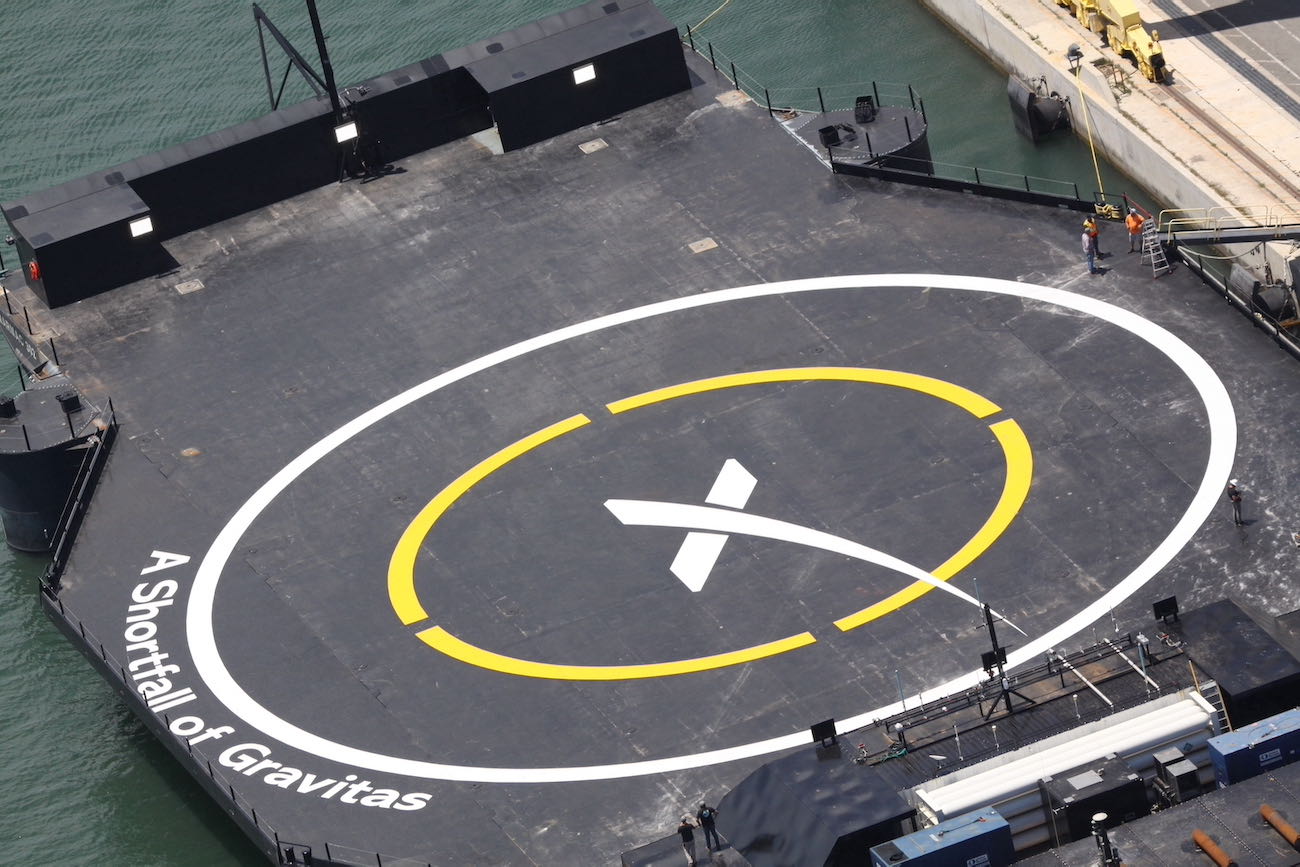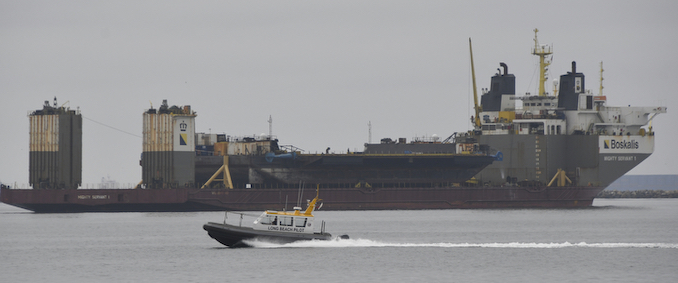A new SpaceX drone ship named “A Shortfall of Gravitas” was towed into Port Canaveral Thursday, completing a shuffling of SpaceX’s rocket landing platforms to support upcoming launches from Florida and California.
“A Shortfall of Gravitas” was towed from a construction facility in Louisiana after completing an initial series of sea trials. SpaceX teams at Port Canaveral will finish readying the drone ship for offshore landings of Falcon rocket boosters.
The name of the new landing platform is a nod to “Experiencing A Significant Gravitas Shortfall,” a starship featured in the “Culture” science fiction novel series by the late Scottish author Iain M. Banks.
SpaceX’s two other drone ships are also named for sentient, planet-sized ships in Banks’ novels: “Just Read the Instructions” and “Of Course I Still Love You.”
The drone ships allow SpaceX to recover and reuse Falcon 9 boosters, cutting costs and increasing the company’s launch rate.
With three drone ships now in its fleet, SpaceX is set up for a regular cadence of flights from Vandenberg Space Force Base in California, following a lull in Falcon 9 launch activity at the West Coast launch site.
SpaceX has launched just one Falcon 9 rocket mission from Vandenberg in the last two years. On that mission, the Falcon 9 booster returned to a landing on a pad near the launch site at Vandenberg.
Beginning as soon as the last week of July, SpaceX plans to launch a series of Falcon 9 missions from Vandenberg carrying Starlink internet satellites into orbit. The Falcon 9 boosters used on those launches will land offshore due to the heavy weight of the Starlink payloads, leaving insufficient propellant on the rocket to reverse course and return to the launch site.
SpaceX recently moved the drone ship “Of Course I Still Love You” from Florida to the Port of Los Angeles in anticipation of the upcoming Starlink missions. The company is expected to launch Starlink missions from Vandenberg as often as once per month, kicking off the next phase of deployment of the global internet network.
The vessel rode on a barge through the Panama Canal before arriving in Southern California on July 6.

SpaceX will use the new drone ship in rotation with “Just Read the Instructions” to support missions from Cape Canaveral. The company previously used a similar rotation of the other two drone ships at Port Canaveral, supporting 20 Falcon 9 launches and landing attempts in the first half of this year.
It can take up to a week to deploy the drone ship, recover the rocket and return it to port, and that assumes no launch delays. Turnaround times can be even longer once the booster is offloaded in port, and the vessel is prepared for another trip to sea. The presence of two drone ships in Florida will allow SpaceX to continue its busy launch schedule.
Later this year, SpaceX will deploy both Florida ships for dual offshore landings of the two side boosters on the next launch of a Falcon Heavy rocket for the U.S. Space Force. SpaceX will expend the Falcon Heavy’s center core stage on that launch due to mission requirements to place the military payloads into a high-altitude geosynchronous orbit, according to a Space Force spokesperson.
Each drone ship is emblazoned with a bullseye with a stylized “X” logo. The landing platform is roughly the size of a football field, and the ships are based on Marmac barge hulls originally built for other purposes.
Elon Musk, SpaceX’s founder and CEO, announced the company was building a third drone ship in 2018.
Autonomous SpaceX droneship,
A Shortfall of Gravitas pic.twitter.com/hNZ5U7nxUg— Elon Musk (@elonmusk) July 9, 2021
“Team did great work! Will be epic to see the deep sea oil rigs converted to ocean spaceports for Starship,” Musk tweeted Thursday, referring to SpaceX’s work to outfit giant oil rigs for launches and landings of the company’s next-generation heavy-lift launch vehicle.
The new drone ship has a sleeker look than SpaceX’s first two rocket landing vessels. It has a Starlink antenna to connect to SpaceX’s space-based broadband network, and support equipment is housed inside the ship’s structure for better protection against rocket blast during landing.
Underwater thrusters allow the ship to hold position in the ocean to await each rocket landing. A support crew is stationed on a nearby ship.
There also improvements to lighting on “A Shortfall of Gravitas,” and Musk tweeted that the new vessel is designed to be fully autonomous, unlike the other two ships, which require a tug to travel to and from the landing zone.

SpaceX has successfully recovered Falcon rocket boosters 89 times since the company’s first rocket landing in December 2015. The first successful booster landing on a drone ship was in April 2016.
Sixty-six of SpaceX’s Falcon booster landings to date have occurred on a drone ship, with another 20 successful touchdowns on SpaceX’s two onshore landing zones at Cape Canaveral Space Force Station. Three Falcon boosters have returned to landing at Vandenberg Space Force Base.
Email the author.
Follow Stephen Clark on Twitter: @StephenClark1.
